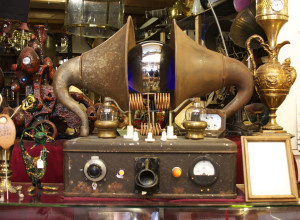By Martha Quillen
Today, technology is advancing so rapidly it’s changing how we socialize, entertain ourselves, get our news,and participate politically. Whether you like it or not, new technology is altering the way we live, work and shop – and also what we buy.
Whether you live in Chaffee County or China, change comes slowly to the hinterlands, but it revved up significantly when television arrived. People, especially children, tend to embrace what they’ve seen on the screen. And with the modern marvels of television translators, cable and satellites, more and more national and international marketing flooded into our homes.
Consequently, we got Ronald McDonald, Colonel Sanders, PacMan, Care Bears, MTV, Transformers, Big Bird, Scooby Doo, Britney Spears, Oprah, Batman, Teletubbies, Ninja Turtles, Power Rangers, Simon Cowell, Justin Bieber, Dora, Diego, Dr. Oz – and all of the related books, posters, action figures and t-shirts that come with popular shows.
Then we got VCRs, ATMs, and the Internet, and now we’ve got cellphones, e-readers, and online shopping.
At some point, the third world joined the technological revolution, and now people around the globe are becoming more interconnected. Today we get toys, food and electronic gadgets from Asia and tech support from India. But tomorrow that could change.
Inconstancy is becoming a constant, even in Leadville, Fairplay and the San Luis Valley. Although those places look the same, chances are the people have phones in their pockets, kids who know how to text, and residents who order their goods online.
New stuff keeps pushing out the old, faster and faster, until even timeworn marvels like newspapers and books seem to be failing.
It’s no secret that print newspapers are in decline. According to a 2012 Pew Research report, the percentage of Americans who still read print newspapers declined from 41 to 23 percent in the preceding decade.
Of course, if you really hate what’s happening, you can still escape to a mountaintop. But unless you’re a mountain goat, you’ll likely come down eventually – and imagine what you’ll find. It could be a whole new world.
If you want to know more about the challenges facing print journalism, the Internet features an almost infinite (in the sense that it is constantly being replenished) supply of information. On the Web, you can find out about the newspaper decline in the U.S., England, France, Germany, China and points beyond.
There’s also speculation about whether print is doomed, not just for newspapers, but for books, too, and about how new technologies are destroying or enhancing – or demoralizing, democratizing, misrepresenting, bankrupting, bankrolling or otherwise affecting – our world.
Which just goes to show why print journalism is failing: You can learn so much more and learn it faster by surfing the Web.
At this point, it’s not clear how the new communication technologies (which include not just online newspapers and magazines, but also blogs, social media, e-books, and homemade videos featuring everything from disasters to performances) will change our world, politics or families. But there’s a lot of conjecture.
Occasionally I talk to people who insist that kids who are raised playing video games and perusing the Net will be deficient in reading, writing and thinking. But that seems unlikely. The Internet actually encourages reading and researching in a way that hanging out at Arnold’s Drive-In did not.
I’ve also picked up several books about how social networking and the Internet are threatening our society, but so far those books have been low on facts and high on alarmism.
T
hen there’s the flip side; a host of technologically savvy supporters welcome the new technologies. My younger daughter, a writer whose work has appeared in print and online, believes e-publishing provides enormous opportunities for authors. “It’s a great time to be a writer,” she assures me.
I’m not as optimistic about the future as Abby, but even that is explained on the Internet. A Pew report released in March of 2014 examines the differences between generations and concludes that the young tend to be more optimistic about the future.
The generation that Pew tags as Millennials (born from 1981 to 1995) are currently having trouble finding jobs, and an unusually large percentage of them are still living at home with Mom and Dad when they’re 30. A whopping 37 percent of Millennials are unemployed, which is the highest percentage for people their age in the last three decades). Yet Millennials expect to someday become successful.
Financial experts are not as optimistic about their prospects. America’s youngest adult population came of age in an era of meager job opportunities and soaring tuitions, and some fiscal experts predict that they will never catch up. However, there’s likewise a hot economic debate about which generation actually has it worse: Millennials or Gen-Xers.
My own kids are classified as Gen-Xers. Now, 34 to 49 years old, this generation typically has kids and homes, but is struggling due to stagnant middle class wages, debt incurred from high education costs, and the mortgage crisis (which in some cases cost them their very first homes and investments).
Yet both Gen-Xers and Millennials are more optimistic about the future than Boomers (born from 1946 to 1964) and the Silent Generation (born from 1928 to 1945).
While generations X and Y grapple with finances, their elders are struggling with technology. Now that more of America’s business and commerce is being conducted online and over the phone, you can fix your computer or television yourself; just call the company and they’ll talk you through it. But people over fifty weren’t raised with a plethora of electronic gadgets and aren’t necessarily pleased with this new development. Millennials, on the other hand, rank their technological prowess as one of their prime assets and gleefully embrace new trends.
Millennials, however, are remarkably similar to their elders in other ways. Although they’re not big on going to church, 86 percent of Millennials say they believe in God, and 58 percent say they are “absolutely certain” God exists. And yes, other generations posted higher percentages. But frankly, all of those numbers struck me as high. Likewise, it surprised me that members of the Silent Generation were the most likely to describe themselves as environmentalists, and Millennials were the least likely. But all in all, less than half of participants of any age described themselves as environmentalists.
But currently there is a trait every generation shares: a growing dissatisfaction with modern politics. Millennials tend to be more confident about our nation’s future than their elders, but their optimism is waning, and for good reason. Millennials tend to support government programs for the elderly, including Social Security and Medicare, but older Americans don’t support their issues. The problems Millennials face (exorbitant tuitions and resultant debt, joblessness and foreign competition for high-tech jobs) are seldom spotlighted.
Technology may be morphing our world, but U.S. politicking seems to be stuck in a rut. We’ve been flailing at each other over Roe vs. Wade for forty years now, and we have been arguing about gun control, immigration and the place of religion and science in our public sphere for two centuries. Citizens are getting tired of all this futile conflict.
During the last couple of years, a lot of people I know, old and young, have told me that they’ve given up on newspapers, television, and politics and that it’s made them considerably happier. But the latest demographics on media and politics suggest that citizens haven’t actually given up, they’ve merely changed their manner of participating. Now Americans are following news and politics online, watching DVDs, and posting, emailing and blogging their views. Let us hope that the Internet is better at bringing people together than our old-fashioned forums.
Martha Quillen contemplates our changing world from the wind-swept slopes surrounding Salida.


